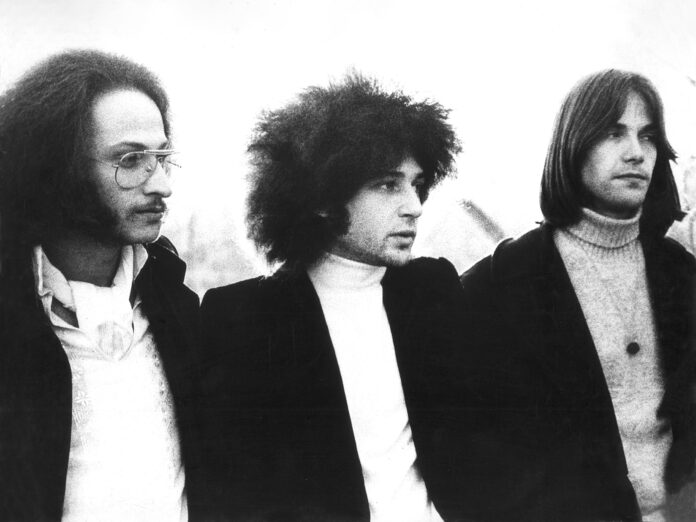His name may not resonate as widely as those of Germany’s kosmische luminaries, but Richard Pinhas is now acknowledged as a significant player on the European electronic-rock scene of the 1970s, through both his solo work and with his band, Heldon. Named after the republic in Norman Spinrad’s bizarre, science fantasy/metafiction work, The Iron Dream, the group have always been essentially a solo project with changing guest lists. Between 1974-79 they released eight albums, before Pinhas was plunged deep into depression in 1983 and all but disappeared for a decade. However, 1992 marked the start of an intensely prolific and ongoing creative streak, featuring many recordings under his own name as well as collaborations with later generations of experimental musicians, including Merzbow, Wolf Eyes, Oren Ambarchi, Stephen O’Malley and Ruins’ Yoshida Tatsuya. Now 72, Pinhas is still recording and playing live; just 18 months ago, Heldon released a new album.
His name may not resonate as widely as those of Germany’s kosmische luminaries, but Richard Pinhas is now acknowledged as a significant player on the European electronic-rock scene of the 1970s, through both his solo work and with his band, Heldon. Named after the republic in Norman Spinrad’s bizarre, science fantasy/metafiction work, The Iron Dream, the group have always been essentially a solo project with changing guest lists. Between 1974-79 they released eight albums, before Pinhas was plunged deep into depression in 1983 and all but disappeared for a decade. However, 1992 marked the start of an intensely prolific and ongoing creative streak, featuring many recordings under his own name as well as collaborations with later generations of experimental musicians, including Merzbow, Wolf Eyes, Oren Ambarchi, Stephen O’Malley and Ruins’ Yoshida Tatsuya. Now 72, Pinhas is still recording and playing live; just 18 months ago, Heldon released a new album.
PINK FLOYD ARE ON THE COVER OF THE NEW UNCUT – ORDER YOUR COPY HERE
Their debut Electronique Guerilla is the latest in their run of ’70s reissues and marks its 50th anniversary in limited-edition, coloured vinyl form. Originally released on Pinhas’s own Disjuncta label, it serves as a great Heldon primer, introducing a delay-heavy style of supremely moody, electronic/cosmic rock that’s undergone minor tweaks down the decades rather than any transformation, while revealing his philosophical, mystical/mythical and futurist interests (he holds a PhD in philosophy from the Sorbonne and studied Kabbalah for years). Pinhas has always seen himself as a rock’n’roll rather than electronic musician, something borne out by his focus on the guitar and his admiration of Hendrix, alongside Eno and the likes of Terry Riley. More importantly, Pinhas’s early influences were ’70s UK blues and R&B guitarists, notably Peter Green, Jimmy Page and Jeff Beck. Later, he fell under the spell of No Pussyfooting, released the year before Heldon’s debut, and is refreshingly upfront about its – and Robert Fripp’s – importance to him.
Much of this is evident on Electronique Guerilla, a potent and absorbing set on its own terms but also one that helped shift focus from Germany’s enticing experimental scene in the ’70s. It was home-recorded direct to tape on a two-track Revox and produced by Pinhas, who plays a Gibson Les Paul and an AKS synth. Magma cohort Patrick Gauthier (on piano and synth) is among those assisting on some tracks. Intriguing details include the album’s dedication to Robert Wyatt, a William Burroughs namecheck on Side One and a reading from Nietzsche’s The Voyager And His Shadow by French philosopher Gilles Deleuze, under whom Pinhas studied.
The set opens with the two-note, sustained drone of “Zind” which, though it bleeds into the start of “Back To Heldon”, is revealed as something of a red herring. In the latter, forlorn and Fripp-ish treated guitar parts undulate over a monotonal and foreboding synth wave, while a single, piercingly relentless note sustains a giallo-style anxiety; alien chatter then guides the track to a calmer place, light years away. “Circulus Vitiosus”, which clocks in at just under nine minutes, suggests a sublime splicing of Fripp/Eno and Tangerine Dream, its bent guitar notes swooning over an orchestra of synth sounds, some of which suggest desperate communications across the void, others stars flaring into existence or flickering before they die. An echo of “Maggot Brain” is hard to deny. In between sit the strikingly contemporary “Ouais, Marchais, Mieux Qu’en 68” (throwing forward to Slint and Godspeed You! Black Emperor), with its Deleuze recitation and the album’s wild card, “Northernland Lady”, which has a blues-drone root and a sweetly hypnotic pull. Here, Pinhas reflects on his two sons about to visit him from Sweden, and their mother. The album closes with the brief “Ballade Pour Puig Antich, Révolutionnaire Assassiné En España”, an elegy for the Catalonian pro-independence militant executed in 1974, which begins with an oceanic gush of synths and adds pulsing synths, over which sit a sombre bass motif and spare, mournful guitar melody.
Half a century on, the “guerilla” of the album’s title may sound like an overheated claim to artistic radicalism, but as Pinhas tells Uncut, as a 22-year-old he wanted to channel “something revolutionary into the sound of the music”, rather than simply be part of the musical vanguard. Heldon’s debut saw him join it on his own terms, speaking to the socio-political disruption of his time while honouring his origins and developing his own signature.



